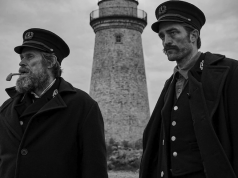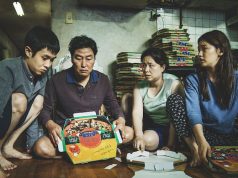One of the things that some “Twilight” detractors don’t like about the book (and especially the movie) is that despite having vampires in it, it’s not a very good vampire story. Its focus is on the romance between the two main characters, not on the supernatural elements; those expecting a Gothic horror come away disappointed.
As an antidote, I recommend “Let the Right One In,” a spectacularly moody film from Sweden in which two lonely 12-year-olds find solace in one another despite (or maybe because of) one of them being a vampire. How can a movie be so tender, poignant, horrific, and gory all at once? More importantly, how can we savor this masterful film before the American remake (yes, one is in the works) ruins it?
The boy is Oskar (Kare Hedebrant), a pale, light-haired loner who you’d think was a vampire but isn’t. The other boys at school pick on him, apparently out of sheer random cruelty, since there’s nothing obviously mock-worthy about him. It’s as if fate selected him for this destiny through no fault of his own. Alone in his bedroom at night, he pathetically rehearses the revenge that he knows he’ll never actually take.
One night in the snowy courtyard outside the apartment building where he lives with his mother, Oskar meets Eli (Lina Leandersson), a girl with darker features and a big, expressive face. She’s as downcast as he is, though somehow more resigned to it. She has confidence, which he lacks. Yes, she’s a vampire.
That issue is not immediately addressed by Eli and Oskar; their friendship simply avoids it and blossoms anyway. Eli is a tormented soul who genuinely mourns every victim, some of whom are procured for her by Hakan (Per Ragnar), an old man who lives with her in a bare apartment and acts as her — what? Caretaker? Father? Something else? Drinking only the blood of animals, as vampires in other fictions have done, doesn’t seem to be an option for Eli, so her plight — dependent on human blood, yet cursed with a conscience — is heartbreaking. Her youth only makes it more so.
Of course, she’s not actually young. In an exchange of dialogue that must appear, in some form, in all stories about vampires interacting with mortals, Oskar asks how old she is and she responds, “I’m 12. But I’ve been 12 for a long time.” That explains her world-weariness. But I like that Lina Leandersson, the talented young actress who plays her, who has never been in a film before, doesn’t go overboard on the “old soul trapped in a young body” thing. Eli still seems like a child, making it even easier to sympathize with her.
As Oskar, Kare Hedebrant (also a newcomer) earns equal sympathy as a naive, innocent boy. Oskar and Eli’s relationship is too young to be sexual; instead, it is merely sweet and symbiotic. He needs her as a protector and supporter, and she needs him as a connection to the human world she has left behind.
The director, Tomas Alfredson (working from a screenplay adapted by John Ajvide Lindqvist from his own novel), films most of the scenes involving vampire attacks with an eerie matter-of-factness, often shooting the murders from a distance, with little camera movement. That makes the depictions more tasteful, yet somehow creepier, too: If there’s anything ghastlier than witnessing a killing, it’s witnessing it detachedly, as an unemotional observer.
Even in moments where the violence is more graphically shown, Alfredson retains a certain stark subtlety. His style, which I like immensely, is polished and assured, unburdened by flashy tricks or choppy editing. Understatement is often the key to an effective thriller. That’s true even in cases like this, where the thriller elements are only part of a larger picture. It’s a haunting, memorable film that’s liable to stay with you long after you’ve seen it.
A- (1 hr., 54 min.; Swedish with subtitles; )





